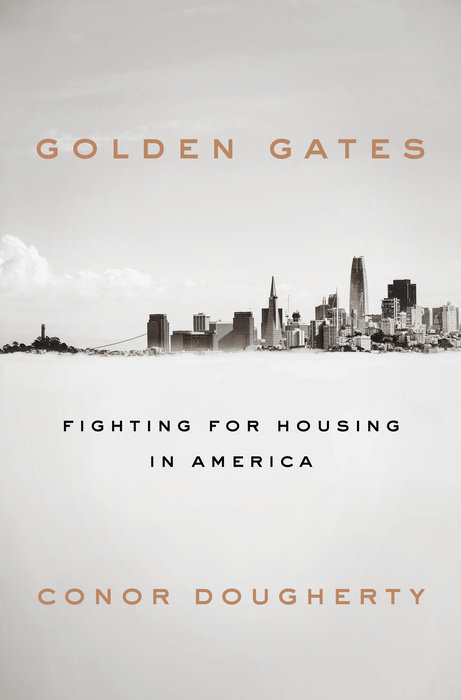The first time I met Conor Dougherty, I’m not sure if he told me that he grew up as a skateboarder in the East Bay or whether I just assumed that he grew up as a skateboarder in the East Bay. Either way, he struck me then, and now, as ideally suited to pound the pavement for stories of California’s housing crisis.
He makes good on that prospect in his recent, unusually timely book Golden Gates: The Fight for Housing in America.
That meeting took place at a rooftop bar in Boulder, Colo., where we were both attending the first-ever YIMBYtown conference (which I covered for Next City). I think some of us hoped that history was being made at what was arguably the first official confab of grassroots housing advocates in any of our lifetimes. I didn’t expect, though, that it would be memorialized in print quite so soon.
The YIMBYtown conference—which Dougherty describes, accurately, as “full of beer and the excitement of several dozen people who thought they are the only person in the world thinking something and were now at a national conference of People Like Them”— appears a few dozen pages into Golden Gates. It was most certainly a pivotal moment in the YIMBY movement, and Dougherty provides an intimate, nuanced look at the origin of the movement and of the successes and failures it has experienced since then. (Disclosure: Dougherty and I have submitted a session proposal for the California American Planning Association conference to discuss our respective books.)
 |
Dougherty’s is an exceedingly contemporary history, and it is largely a narrative history. He does not dwell on the origins of the housing crisis or on the reams of data quantifying the crisis but rather focuses on the personalities and political battles over housing.
He starts with Sonja Trauss, the Oakland-based activist who is generally credited with sparking the YIMBY movement. Trauss started the San Francisco Bay Area Renters Federation—famously abbreviated SF-BARF—as a collectivist, DIY, quasi-libertarian and entirely pissed off group to provide grassroots advocacy for proposed housing developments in Oakland, San Francisco, and environs. Fundamentally, YIMBYism has always meant to serve as a counterweight to entrenched and often unopposed political power of homeowners. She wanted to flip the conventional script in which "people who spent most of their time talking about subsidies and rent control were affordable housing advocates. People who talked about making it easier to let the private market build housing were developer shills."
Anyone who has met Trauss or heard her speak understands that SF BARF’s initial success was due in large part on the force of her personality. She is energetic, outspoken, and unmissable as a sort of punk rock policy wonk. This is where Dougherty’s street smarts come in handy. He captures Trauss and other personalities behind the movement in ways that neither shouting matches in a city council meeting nor white papers published by think tanks ever could.
Dougherty also focuses on Trauss’s less anarchic counterpart, State Sen. Scott Weiner, the political superstar of the YIMBY movement. By Dougherty’s account, Wiener, a Harvard-educated lawyer, relinquished his social life while on the Board of Supervisors and instead cranked out reams of legislation (starting with an infamous ban on public nudity, which was formerly legal and, apparently, common). His prolixity propelled him to state office, where he championed the infamous density bills SB 827 and SB 50. Both failed, but Dougherty credits him for raising the profile of housing, and he describes Wiener as being perhaps more closely in league with the YIMBY establishment—such as there is one—than most stakeholders might have realized. Likewise, Dougherty chronicles Trauss’s unsuccessful bid to follow in Wiener’s footsteps by running for San Francisco supervisor.
Crucial battles in the YIMBY movement include Trauss’s campaign to “sue the suburbs,” in which she used an obscure provision of the Housing Accountability Act to sue both the suburban city of Lafayette and a developer for downzoning a development. There are also tangents into the promise of prefabricated housing (the jury is still out) and the problems with rent control (convicted on many occasions).
Dougherty weaves in some elegant history in the first third of the book. Just enough history (especially on postwar exuberance, Prop 13, and William Fischel’s “home voter” thesis) and just enough scholarly research to explain how we got here. He also adds some great analysis about public finance, local control, and the perils of “contract cities,” which can control their own land use but simply pay for everything else. The result, writes Dougherty: "a city that is run primarily to reduce costs is a city that does everything it can to draw in things and people that generate the most taxes well keeping out people who are likely to need affordable homes or financial help."
As a work of political science, Golden Gates is fascinating for illustrating how a political movement can evolve in relatively short order—and the challenges that come with maturity. It tracks YIMBYism from the DIY collective of SF-BARF’s “do-ocracy” to the development of the statewide organization California YIMBY and a variety of local groups that replaced SF BARF with far more professional organizations. He also reveals internal struggles, based in different versions of YIMBY philosophy. It’s the rare political movement in which the libertarian faction squares off against the socialist faction. Such are the complexities of California housing policy.
Despite the book’s subtitle, Fighting for Housing in America, the book’s primary title is not just more poetic but also more accurate. Dougherty makes a few nods toward Los Angeles, where the anti-growth AIDS Healthcare Foundation has formed a “curious alliance" with social justice activists in South L.A., and he mentions various YIMBYtown conferences around the country. Nonetheless, Golden Gates concerns not so much housing in America as it does housing in the Bay Area. In Dougherty's defense, the Bay Area battles are surely the country’s most interesting (Los Angeles’s YIMBY’s, with whom I am familiar, are a more low-key bunch than Trauss and many of her colleagues), and they have lessons for many metro areas where supplies are low and prices are high. But the region has little, if anything, to do with the many cities plagued by vacancies and under-investment.
I suspect that Dougherty faced, and was well aware of, two fundamental challenges of chronicling the YIMBY movement: that of timing and of objectivity. I’ll get to objectivity in a moment.
As for timing, Dougherty was in the right place at the right time. He moved back to the Bay Area in 2013 and was given wide latitude by his New York Times editors to cover the evolution from crunch to crisis. Golden Gates is nothing if not of the moment. The end of the story is far less certain. History is evolving on a literally daily basis, and the results of YIMBYism—or lack thereof—are a long ways off. The crisis will either get incrementally better, in part thanks to recently passed state laws and a greater appetite for development generally, or it will get much worse. Or maybe YIMBY’s, homeowners, and Democratic Socialists will one day converge on Union Square at high noon and bludgeon each other to death with bound volumes of The Wealth of Nations and Das Kapital. Anything is possible in San Francisco. Golden Gates’ strength is that it brings us up to speed and, perhaps, gives YIMBYs an ideal opportunity to reflect on the past decade and prepare for the next.
As for objectivity, I think many housing activists assume that Dougherty is a YIMBY because they associate him with YIMBYs. Those assumptions are exaggerated, at best. The movement fascinates Dougherty, just as the housing crisis troubles him. But, while Dougherty clearly enjoys hanging with YIMBYs, at watering holes and conference halls alike, and believes that they are important stakeholders, he remains an objective reporter, perhaps with a gonzo streak. Dougherty is an apt foil for, say, Peter Moskowitz, whose antipathy for capitalism in How to Kill a City borders on comical. Ultimately, the same could be said for Dougherty as could be said for the entire housing debate: “all this makes land schizophrenically capitalist and socialist, creating a vacuum that allows people to see whatever system they want to see.”
Dougherty hardly believes that YIMBYism will solve California’s problems. He makes essential concessions to tenant rights activists and acknowledges threats like eviction and gentrification (though he is rightfully unkind to the AIDS Healthcare Foundation). At heart, Dougherty is an advocate for his home region and for the people in it. He titles his epilogue, “Neighbors for More Neighbors,” after a centrist and appealingly friendly advocacy group in Minneapolis. He clearly aches for the opposing sides to find common ground, wishes for YIMBYIsm's rival factions to cool it, and favors nuanced solutions and broad stakeholder participation.
Sometimes those stakeholders are on the board of supervisors. Sometimes they are on skateboards.
Golden Gates: The Fight for for Housing in America
Penguin Press
Feb 18, 2020
288 Pages
$28.00 Hardcover

